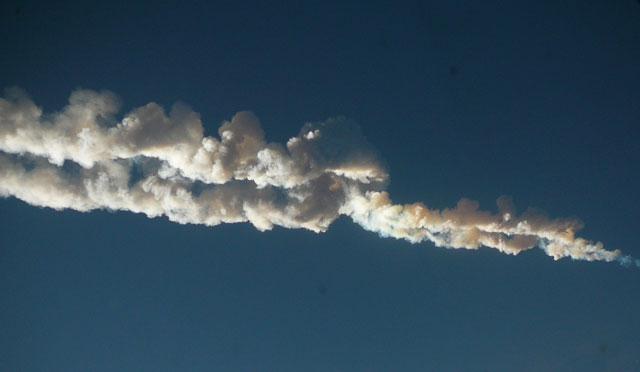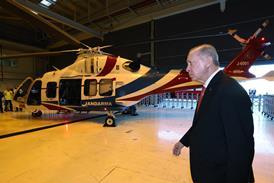While awareness that a cataclysmic meteor strike could end life on Earth as we know it is hardly new, events this year have rung alarm bells and flagged up the gap between our detection capabilities and the astonishing number of threats lurking in space. However, significant new resources are being mustered to search the night sky for hazards, and experts are remarkably optimistic that, given warning, large objects could be deflected from collision paths with Earth.
A meteor strike is widely agreed to have killed off the dinosaurs 66 million years ago, and other mass extinctions may also have been caused by impacts; the prospect of mayhem from space has even been a favourite theme for film makers. But until February 2013 modern experience has been limited to the 1908 Tunguska event, in which a meteor of perhaps 100m diameter destroyed a remote forest area of Siberia, unleashing the power of a large nuclear bomb, probably in an air burst.
But if Tunguska represented in the popular imagination an event nearly as remote as the end of the dinosaurs, perceptions changed on 15 February 2013. That day - as widely anticipated - asteroid 2012DA14, the size of a building and weighing 130,000 tonnes, whizzed past Earth, closer than many satellites orbit, at some 45,000kmh. And, totally out of the blue, an unknown object around 18m in diameter and travelling at 66,000kmh entered the atmosphere and exploded above Chelyabinsk, Russia, with 20-30 times the energy of the bomb that destroyed Hiroshima.
 |
|---|
Nikita Plekhanov/Wikimedia On 15 February 2013 an object around 18m in diameter entered the atmosphere and exploded above Chelyabinsk, Russia, with 20-30 times the energy of the bomb that destroyed Hiroshima |
Though described by the European Space Agency as "relatively small", the Chelyabinsk meteor was the largest known natural object to enter the atmosphere since Tunguska, and it was widely photographed. Fortunately, its path through the air was shallow and it exploded at high altitude, so while the shock wave caused widespread damage and injuries, the result was not calamitous.
Also fortunately, experts in so-called near Earth objects (NEOs) are far more aware of the problem and have been directing a great deal of attention to it for years. At NASA, the budget for tracking NEOs was raised in 2012 to $20 million, from $6 million. So far, NASA and other US observers have made most of the running in planetary protection, laying claim to the discovery of more than 98% of the known NEOs.
But ESA has entered the game in a significant way, with the opening on 22 May of a data hub to co-ordinate its own search for NEOs, and effectively process and share that information with NEO searchers within Europe and farther afield. The NEO Coordination Centre at ESA's Earth observation centre at Frascati, Italy, is part of an ongoing five-year programme to boost Europe's broader space situational awareness capability, including the monitoring and study of space weather. The Space Weather Coordination Centre was opened in Brussels earlier this year.
As ESA's head of NEOs Detlef Koschny puts it, for all NASA's efforts there is still not enough being done. Indeed, the scale of the problem is daunting. There are more than 600,000 known asteroids in the solar system, including nearly 10,000 classified as NEOs.
ESA's contribution promises to bring some serious technological firepower to bear on the NEO problem. Koschny is enthusiastic about Fly-Eye, a new concept in multi-lens telescopes that will feature a wider field of view than any existing optics. The project has a budget of nearly €10 million ($13 million) over the period to 2016 to build a prototype.
With Fly-Eye, says Koschny, ESA will be able to scan the entire sky every night, compared with the roughly once-monthly scan of equipment NASA has currently dedicated to NEOs.
Ramping up the search for NEOs, and of course tracking their orbits, is the first critical part of any bid to protect Earth from impact. And, stresses Koschny, the sort of data co-ordination being established by ESA at Frascati - and operating at NASA's Near-Earth Object Program Office at its Jet Propulsion Laboratory in Pasadena, California - is indispensable. Simply, he says, the search for NEOs is a bigger job than any one agency can manage.
He adds it is also important to maintain a "permanent, sustained, continuous" tracking programme. Too many such efforts, particularly in Europe, have been university-based and lose momentum with the departure of a key professor.
NOT JUST STANDING BY
But, ultimately, detection is pointless if nothing can be done beyond alerting people to an impending end of the world. Here, though, the outlook is bright; Koschny goes so far as to describe himself as "very optimistic".
Three techniques, he believes, could realistically be employed to deflect an asteroid off an Earth-collision course. One would be a kinetic impact, to "nudge" an asteroid to a new path. A second would be to send a spacecraft alongside, to act - with careful guidance - as a "gravity tractor"; Koschny believes ESA has developed the navigational competence to stay close enough. The third would be to fix an ion engine to the rock, and thrust it off course.
Much is being done to make such schemes possible. In 2016, NASA will launch a robotic probe, OSIRIS-Rex, to one of the most potentially hazardous of the known NEOs, to pave the way for future reconnaissance missions to threatening objects. The agency has also begun devising a mission to identify, capture and relocate an asteroid, in part to study its composition.
Koschny is hopeful that ESA's plans for an asteroid sample return mission, named Marco Polo, will be selected for funding in February 2014. In addition to its obvious scientific merit, the mission would test Koschny's contention that navigational technology is up to gravity tractor standards.
Given, say, 10 years' warning, Koschny believes a joint effort by NASA, ESA and maybe JAXA, the Japanese space agency, could save the world from disaster. Precedent for collaboration is good, he says, and the probable approach would be collaboration-friendly. Expect the plan to call for a pair of launches: one to make a kinetic impact, followed by a second tractor mission.
Today, clearly, the NEO question falls into the important but not urgent category of budget priorities. But Koschny says: "If we found something we believed would hit us, believe me the money would be there."
Source: Flight International


























